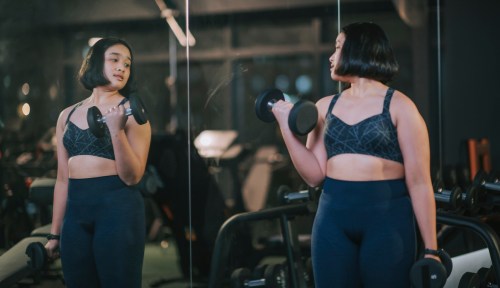It’s Time for Fitness Studios To Be More Thoughtful About Mirrors
Mirrors are neutral, but people aren't. Here's why it's time to be more thoughtful about putting mirrors in fitness studios.

When the owners of Burn Boot Camp transitioned from holding workouts in a parking lot to building out a brick and mortar studio in 2015, they had a decision to make: To put in mirrors, or to go mirror-free? They spoke with their clients—who were all women, including many who were mothers—and they came to a conclusion.
Experts in This Article
associate professor and co-director, Sport and Performance Psychology
Graduate School of Professional Psychology, University of Denver
“It was a no-brainer to not make the 45 minutes that [our clients] get and that they’re committing to themselves a place where they feel intimidation or insecurity,” Morgan Kline, Burn Boot Camp CEO and co-founder, says. “Whether they absolutely love everything about their body, or they don’t, we don’t want those distractions when they’re in Burn Boot Camp.”
Kline and her husband Devan have stood by that decision as they’ve grown from one studio to five, and then began a franchise business. There are now over 330 Burn Boot Camp locations throughout the U.S., and it is policy to not have mirrors in any of the studios.
Why all the fuss about mirrors? Because the environment that someone works out in can affect variables like self-confidence and motivation, according to Jamie Shapiro, PhD, an associate professor of sports psychology at Denver University. And mirrors can cut both ways.
“It depends on the person’s interpretation of what they’re seeing in the mirror,” Dr. Shapiro says. “What we think when we see ourselves in the mirror exercising might be useful for some people and detrimental for others.”
One person might be able to use the mirror as a tool to assist with their form. They could also look at themselves in a mirror and get the message that they’re strong and capable, and adept at the task (a concept known as “self-efficacy”).
“I’m seeing myself exercise, and that’s giving me reinforcement that I’m doing something healthy for myself, or I’m accomplishing something,” Dr. Shapiro says. “And so in that way, I think it could be useful.” Research from 2001 showing that working out in front a mirror increases self-efficacy supports this idea.
On the other end of the spectrum, however, the mirror might cause someone to pick apart their appearance, or compare themselves to other gym-goers. That could sour their relationship with exercise, or deplete their self-esteem, as one 2003 study found.
“That can be taking up mental energy that’s taking away from the workout,” Dr. Shapiro says. Instead of focusing on how the movement feels, we can easily get caught up in how we look and develop tunnel vision around the body parts we’re insecure about. (It may not be a coincidence that much of the fitness industry subsists on providing “solutions” to these perceived flaws.)
In a blog post, The Bar Method, a nationwide barre class studio, writes that its roots as an exercise inspired by ballet contribute to its decision to have mirrors in studios. Ballet dancers need constant visual feedback to refine every movement of their body, since the aesthetic art form they’re practicing is incredibly precise.
This justification, however, doesn’t recognize the reality that dancers are preparing for performances, while barre class is simply a place to get exercise. Still, in its post, the Bar Method argues that the benefits mirrors can have outweigh the risks of comparison or self-criticism. It is up to clients to make positive use of the mirror. The blog post quotes an interview in Dance Magazine with former president of the American Psychological Association, Dr. Nadine Kaslow, to explain.
“It’s important to resist the urge to compare your appearance to others or dwell on the physical attributes you don’t like,” Dr. Kaslow says. “Instead, redirect that energy into appreciating your body for all it can do and use the mirror as a way to center yourself throughout your workout.”
That might be easier said than done in our appearance-focused society. Mirrors are not inherently a tool for either self-appreciation or self-criticism. The mirror itself is neutral. But humans—and cultural forces like the diet industry—can impact what that person sees, and therefore the mirror’s effect.
“A lot of the time people don’t like looking at themselves,” Kline says. “They don’t like what they’re seeing in the reflection, and we don’t want that to be another reminder during their workout.”
For this reason, Dr. Shapiro believes that studios should be “more thoughtful” about whether or not to have mirrors, rather than making reflective surfaces the default. Perhaps studios can survey their customers, she suggests. Other ideas could be to only put mirrors in half of a classroom, or even provide choice by offering some classes in which mirrors are covered by a curtain.
Mirrors should be as intentionally considered as other fitness industry norms, like how hard a workout should be and clients’ reasons for exercising. These norms often boil down to personal choice, and mirrors are no different. It’s time for some, yes, reflection on how we can help everyone get the kind of workout they crave.
Sign Up for Our Daily Newsletter
Get all the latest in wellness, trends, food, fitness, beauty, and more delivered right to your inbox.
Got it, you've been added to our email list.










